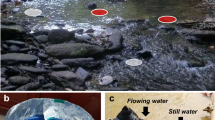Abstract
Head-bobbing walking (HBW) and non-bobbing walking (NBW) of black-headed gulls were compared from kinematic and behavioral/environmental viewpoints. The birds walked with a longer stride length and lower stride frequency during the HBW than during the NBW. With respect to these two parameters, the HBW of black-headed gulls was similar to that of other head-bobbers, and the NBW was similar to that of other non-bobbers. The stride length and the amplitude of head bobbing were correlated. These results suggest that the head-bobbing and gait parameters are related. From a behavioral viewpoint, HBW was observed during seeking-type foraging by wading, and NBW was observed during waiting-type foraging on a flat substrate. The type of foraging behavior and/or substrate condition probably determines whether the birds walk with or without head bobbing.







Similar content being viewed by others
Abbreviations
- DTT:
-
Distal tarsometatarsus
- HBW:
-
Head-bobbing walking
- MTT:
-
Middle of the tarsometatarsus
- NBW:
-
Non-bobbing walking
- PPT:
-
Proximal tarsometatarsus
References
Abourachid A (2000) Bipedal locomotion in birds: the importance of functional parameters in terrestrial adaptation in Anatidae. Can J Zool 78:1994–1998
Abourachid A, Renous S (2000) Bipedal locomotion in ratites (Paleognatiform): examples of cursorial birds. Ibis 142:538–549
Abourachid A (2001) Kinematic parameters of terrestrial locomotion in cursorial (ratites), swimming (ducks), and striding birds (quail and guinea fowl). Comp Biochem Physiol A 131:113–119
Alexander RMcN, Jayes AS (1983) A dynamic similarity hypothesis for the gaits of quadrupedal mammals. J Zool Lond 201:135–152
Daanje A (1951) On locomotory movements in birds and the intention movements derived from them. Behaviour 3:48–98
Dagg AI (1977) The walk of the Silver gull (Larus novaehollandiae) and of other birds. J Zool Lond 182:529–540
Davies MNO, Green PR (1988) Head-bobbing during walking, running and flying: relative motion perception in the pigeon. J Exp Biol 138:71–91
Dunlap K, Mowrer OH (1930) Head movements and eye functions of birds. J Comp Psychol 11:99–113
Friedman MB (1975) Visual control of head movements during avian locomotion. Nature 225:67–69
Frost BJ (1978) The optokinetic basis of head-bobbing in the pigeon. J Exp Biol 74:187–195
Fujita M (2002) Head bobbing and the movement of the center of gravity in walking pigeons (Columba livia). J Zool Lond 23:373–379
Fujita M (2003) Head bobbing and the body movement of little egrets (Egretta garzetta) during walking. J Comp Physiol A 189:59–63
Fujita M, Kawakami K (2003) Head bobbing patterns, while walking, of black-winged stilts Himantopus himantopus and various herons. Ornithol Sci 2:59–63
Fujita M (2004) Kinematic parameters of the walking of herons, ground-feeders, and waterfowl. Comp. Biochem Physiol A 139:117–124
Gatesy SM, Biewener AA (1991) Bipedal locomotion: effects of speed, size and limb posture in birds and humans. J Zool Lond 224:127–147
Green PR, Davies MNO, Thorpe PH (1998) Head-bobbing and orientation during landing flights of pigeons. J Comp Physiol A 174:249–256
Muir G.D, Chu TK (2002) Posthatching locomotor experience alters locomotor development in chicks. J Neurophysiol 88:117–123
Pratt DW (1982) Saccadic eye movements are coordinated with head movements in walking chickens. J Exp Biol 97:217–223
Troje NF, Frost BJ (2000) Head-bobbing in pigeons: How stable is the hold phase? J Exp Biol 203:935–940
Wallman J, Letelier JC (1993) Eye movements, head movements, and gaze stabilization in birds. In: Zeigler HP, Bischof HJ (eds) Vision, brain, and behavior in birds. MIT, Cambridge, pp 245–263
Author information
Authors and Affiliations
Corresponding author
Rights and permissions
About this article
Cite this article
Fujita, M. Head-bobbing and non-bobbing walking of black-headed gulls (Larus ridibundus). J Comp Physiol A 192, 481–488 (2006). https://doi.org/10.1007/s00359-005-0083-4
Received:
Revised:
Accepted:
Published:
Issue Date:
DOI: https://doi.org/10.1007/s00359-005-0083-4




